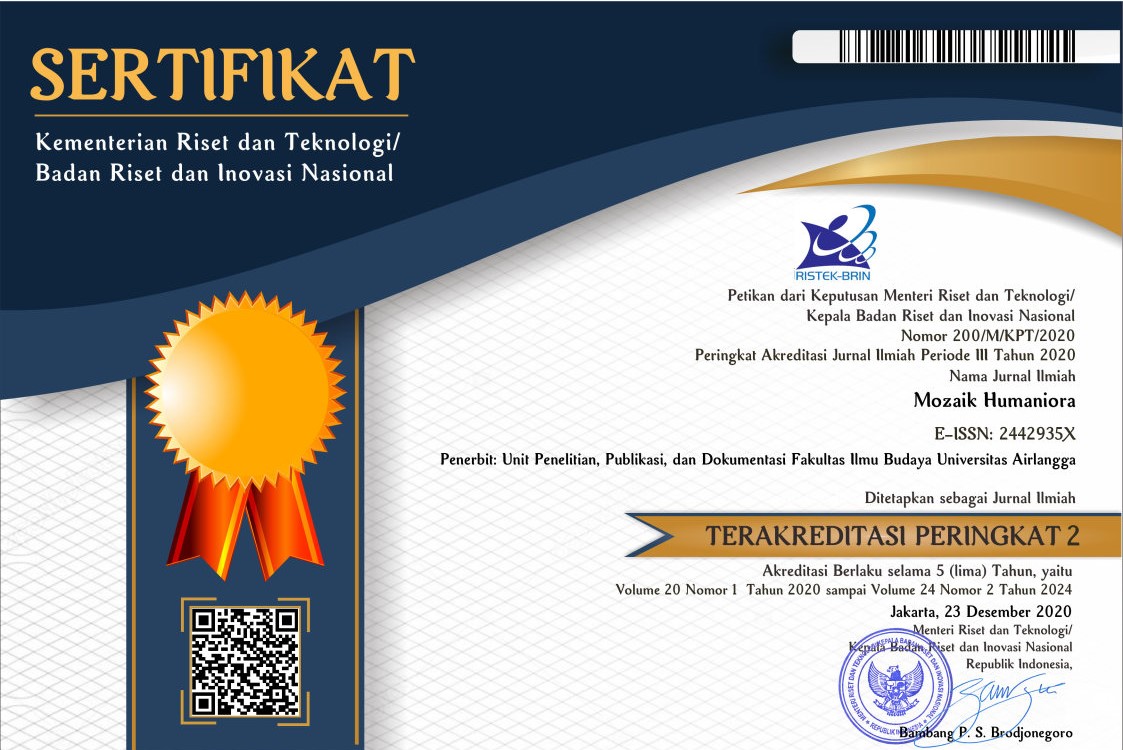Cultural Recontestation of Chinese Ethnicity in Surakarta City During the Reformation Era
Downloads
One of the assimilation policy implementations during the New Order era was prohibiting the display of Chinese traditions and culture in public. This discriminatory policy ended in the Abdurahman Wahid Presidential era, marked by the revocation of Presidential Instruction No. 14 of 1967 through Presidential Decree No. 6 of 2000. The Chinese community regained the rights to publicly practice their religion, traditions and culture. This study investigates the forms of Surakarta Chinese community’s cultural recontestation after this revocation. This study uses historical method. Primary sources include archives of Inpres No. 14 of 1967 and no. 26 of 1998, Kepres No.6 of 2000 and interview data. The results show that after the revocation of Inpres No. 14 of 1967, the Surakarta Chinese community regained the freedom to practice their religion, traditions, and culture in public, such as praying at the temple, holding Grebeg Sudiro Festival during the Chinese New Year, revitalizing Balong Chinatown village while maintaining typical Chinese architecture, increasing the number of temples, and making Kalipepe River Bandar in Balong Chinatown village as a tourist destination. This study concludes that the Chinese community in the reformation era has regained their space for cultural contestation in public.
Danandjaja, James. 2007. Foklor Tionghoa Sebagai Terapi penyembuh Amnesia terhadap Suku Bangsa dan Budaya Tionghoa. Jakarta: Pustaka Utama Grafiti.
Fatimah, I. Chinatown Growth in Surakarta from The Colonial Era to The Millennium Era (XVIII-XX Century). Sinolingua: Journal of Chinese Studies, 1(1), 15-38. https://dx.doi.org/10.20961/sinolingua.v1i1.70954
Fittrya, Laylatul. 2013.” Tionghoa dalam Diskriminasi Orde Baru 1967-2000, Avatara: e-Jurnal Pendidikan Sejarah, Vol.1 No. 2.
Hoon, Chang You. 2012. Identitas Tionghoa pasca Soeharto: Budaya, Politik dan Media. Jakarta: LP3ES.
Hakim, Latifa Dinar Rahmani. 2020. "Grebeg Sudiro dan Representasi Keberagaman di Sudiroprajan, Kota Surakarta”, Indonesian Journal of Religion and Society, Vol.02 (01). DOI: 10.36256/ijrs.v2i1.74.
Ofita Purwani, Ogif Ratunar Rahmatulloh, dkk. 2022.”Invented Traditions in Surakarta after Desentralisation”, Cities, Vol. 131. Desember, 103985. https://doi.org/10.1016/j.cities.2022.103985.
Aliyah.I, Bambang Setioko, dll. 2017. "Spatial Flexibility in Cultural Mapping of Traditional Market area in Surakarta: case Study of Pasar Gede in Surakarta”, City, Culture and Society, Vol. 10, September. https://doi.org/10.1016/j.ccs.2017.05.004.
Lydiana Salim, Akhmad Ramdhon. 2020. "Dinamika Konflik Kerusuhan Mei 1998 di Kota Surakarta Melalui Prespektif Korban”, Journal of Development and Social Change, Vol. 3, No. 1, April p-ISSN 2614-5766. https://jurnal.uns.ac.id/jodasc.
Purbasari, V. Ayuningsih dan Suharno. 2019. ”Interaksi Sosial Etnis Cina-Jawa Kota Surakarta”, Jurnal Antropologi: Isu-isu Antropologi, Vol. 21, No.11. https://doi.org/10.25077/jantro.v21.n1.p1-9.2019.
Alam, M. B. S. Acculturation of Java and Chinese Culture in Historical Perspective. Sinolingua: Journal of Chinese Studies, 1(1), 1-14. https://dx.doi.org/10.20961/sinolingua.v1i1.68944
Koentjaraningrat. 2015. Pengantar Ilmu Antropologi. Jakarta: Aksara Baru
Lombard, Denys. 2000. Nusa Jawa Silang Budaya. Jakarta: Gramedia Pustaka Utama
Rustopo. 2007. Menjadi Jawa: Orang-orang Tionghoa dan Kebudayaan Jawa di Surakarta 1895-1998. Yogyakarta: Penerbit Ombak.
AS Hikam, M. 1996. Demokrasi dan Civil Society. Jakarta: LP3ES.
Crowther, J.1996. Oxford Advanced Learner's Dictionary of Current English. with a Special Supplement of Indian English.
Fredy B.L. Tobing. 2013. Praktik Relasi Kekuasaan Soeharto dan Krisis Ekonomi. Jakarta: Penerbit Kompas.
Jenkins, Richard. 1992. Membaca Pikiran Pierre Bourdieu. Bantul: Kreasi Wacana.
Taniputera, Ivan. 2008. History of China. Yogyakarta: Ar-Ruzz Media
Basri. 2006. Metodologi Penelitian Sejarah (Pendekatan, Teori dan Praktik). Jakarta: Restu Agung.
Yuanzi, Kong. 2013. Cheng Ho, Muslim Tionghoa Misteri Perjalanan Muhibah di Nusantara. Jakarta: Yayasan Pustaka Obor Indonesia.
Suhandinata, Justian. 2009. WNI Keturunan Tionghoa dalam Stabilitas Ekonomi dan Politik Indoneia. Jakarta: Gramedia Pustaka.
Juwono. 1999. "Etnis Cina di Surakarta 1890-1927: Tinjauan Sosial Ekonomi”, Lembaran Sejarah, Vol: 2.
Humprey, Michael. 2002. The Politics of Atrocity and Reconciliation. London and New York: Routledge.
Mujib, Ibnu. 2008. ”Pembauran Agama Strategi Politik Kebudayaan”, el-Harakah, Vol.10. No.3 September-Desember.
Suryadinata, Leo. 2010. Etnis Tionghoa dan Nasionalisme Indonesia: Sebuah Bunga Rampai 1965-2008. Jakarta: Penerbit Kompas.
Suryadinata, Leo. 1984. Dilema Minoritas Tionghoa. Jakarta: Grafiti Pers
Rahardi.B.N. 1998. Rekaman Lensa Peristiwa Mei 1998. Surakarta: Aksara Solopos.
Mulyadi, H.M., Soedarmono, dkk. 1999. Runtuhnya Kekuasaan Keraton Alit: Studi Radikalisasi Sosial "Wong Solo” dan Kerusuhan Mei 1998 di Surakarta). Surakarta: LPTP Press.
O'Donnel, Guillermo dan Philippe C. Schmitter. 1993. Transisi Menuju Demokrasi: Rangkaian Kemungkinan dan Ketidakpastian. Jakarta: LP3ES.
Widyaningsih, Raffa dan Andrik Purwasito. 2015. "Misi Suci” Grebeg Sudiro: Studi Eksploratif Pesan Ritual Budaya Grebeg Sudiro dalam rangka Persatuan Masyarakat di Kota Surakarta (Skripsi), Program Studi Ilmu Komunikasi, Fakultas Ilmu Sosial dan Ilmu Politik Universitas Sebelas Maret.
Copyright (c) 2024 Rudiansyah, M Bagus Sekar Alam, Tati Sugiarti, Ulfah Yanuar Lianisyah

This work is licensed under a Creative Commons Attribution-ShareAlike 4.0 International License.

Mozaik Humaniora is licensed under a Creative Commons Attribution-ShareAlike 4.0 International License. Both authors and Mozaik Humaniora agree with the following attribution of journal:
1. Copyright of this journal is possession of Author, by the knowledge of the Editorial Board and Journal Manager, while the moral right of the publication belongs to the author.
2. The journal allows the author(s) to retain publishing rights without restrictions
3. The legal formal aspect of journal publication accessibility refers to Creative Commons Attribution Share-Alike (CC BY-SA).
4. The Creative Commons Attribution Share-Alike (CC BY-SA) license allows re-distribution and re-use of a licensed work on the conditions that the creator is appropriately credited and that any derivative work is made available under "the same, similar or a compatible license”. Other than the conditions mentioned above, the editorial board is not responsible for copyright violation.


















